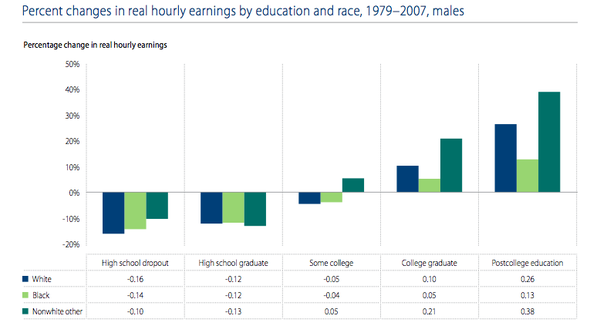The Hollowing Out of America's Middle Class
The common and responsible thing to say about college is: go! The statistics are persuasive. In the last 30 years, real earnings have increased for men who finish college and go on to graduate degrees, while they have fallen for the rest. This chart courtesy of the Hamilton Project makes the picture very clear:

Here's the central paradox of American jobs and education. While benefits from going to college are increasing exponentially, the fastest growing jobs aren't for high-earning college graduates. They're for low-wage workers. Retail sales persons, cashiers, and food preparation workers are adding more jobs than any in the country. Their combined median wages are below $10.

Not so fast. Even today, the more education you have, the more likely you are to have a job. Cheap work is easier to find these days, but maybe that's normal. We should expect nervous employers to add clerks and temps before they free up $300,000 to add a senior account manager.
Instead, something more complicated is happening. The first graph showing wages rising for the highly educated and falling for the less-educated makes education sound like an elevator. The longer the stay, the higher you go. But the market is really less like an elevator and more like two floors without a staircase to connect them. Job opportunities are growing at the top, where wages are rising, and at the bottom, where wages aren't. But opportunities for middle-education, middle-paid workers have frozen over the last two decades.
Health care will add more workers than any industry in the next decade, according to the BLS. Many of those jobs only require little more than medium-term training. The seven fastest growing jobs in health and human services don't require a bachelors degree, at all. It's rote to say that an economy run on smarter phones and smarter grids requires smarter workers. But it's more true to say, as Michael Luo does, that the economy is cleaved in two. "Highly-educated, high-paid occupations that demand significant amounts of education and training [are] growing rapidly," but so are "low-wage, entry-level, service-type jobs that do not require much schooling or special skills."
To really see this hollowing out of the labor force, check this second graph from Hamilton. From left to right, education requirement and wages are decreasing. We know the high and low ends are more resilient today. But this isn't new. We've been soft in the middle for the last 30 years.

The Hamilton paper concludes that technology and globalization are vacuuming up all the opportunities for our soft middle class. "Rising demand for highly educated workers, combined with lagging supply, is contributing to higher levels of earnings inequality," the authors write. "Demand for middle-skill jobs is declining, and consequently, workers that do not obtain postsecondary education face a contracting set of job opportunities."
This makes it sound like demand for middle-class work is only floating up to highly educated workers. But it's also flowing down, to retail and grounds cleaning and, especially, health care -- positions that don't require much post-high school education at all. Is $160,000 of college right for this group, too?
THE NEXT ECONOMY
America 2020: Health Care Nation
Four Horsemen of the Job-pocalypse
What If Education Fails to Fix the Jobs Crisis?
The Hallowing Out of America's Middle Class